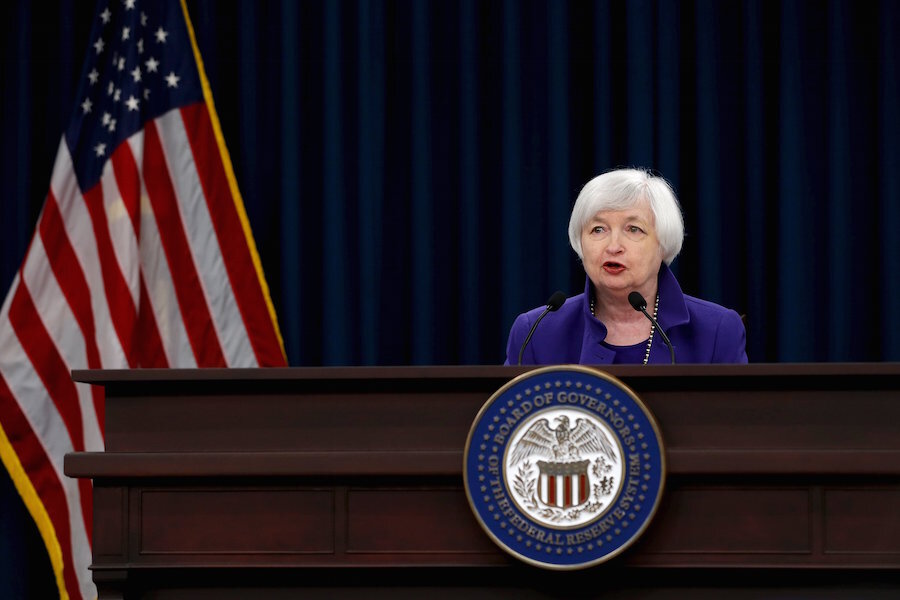Federal Reserve raises key interest rate, but it’s still a great time for borrowers
Loading...
After nearly a full year of false starts, questionable data, and stock market jitters, the Federal Reserve announced an increase of key interest rates for the first time in nearly a decade Wednesday. The announcement put a cap on a monetary policy meant to steer the country away from another Great Depression when the economy went reeling back in 2008. It worked, and by many measures, the US is back to its pre-Recession shape.
Citing an expanding economy, increased household and business spending, and a steadily improving job market, the Federal Open Market Committee FOMC) "decided to raise the target range for the federal funds rate to 1/4 to 1/2 percent," according to a 2 p.m. press release from the Federal Reserve.
In a press conference following the announcement, Fed chair Janet Yellen outlined improvements in the economy that prompted the decision, but cautioned that low rates are still appropriate due to certain weaknesses, chiefly low inflation. "With the economy performing well, and expected to continue to do so, the committee judged that a modest increase in the federal funds rate target is now appropriate, recognizing that even after this increase, monetary policy remains accommodative," she said.
A long time coming
Because of its long delay, as well as heavy hints from Fed officials in recent weeks, the hike announcement was a surprise to virtually no one. According to a Wall Street Journal survey from a week ago, 97 percent of both academic and industry economists expected it. When the financial markets caught wind of a possible rate hike several months ago, stocks reeled; economic uncertainty abroad, a few uneven months of US job growth, and a stubbornly low inflation rate sidelined a hike that had been anticipated by many in the fall.
That hasn’t been the case this time. On Tuesday, financial services stocks surged in the lead-up to the announcement, as higher borrowing rates are expected to make more money available to banks and lenders. On Wednesday, the Dow was up 107 points minutes after the Fed's release.
If anything, this first increase is somewhat of a relief to investors, and any uncertainty stems from how the Fed will proceed in the coming year. “The move will alleviate uncertainty surrounding the monetary policy change that has been an overhang on the markets since September," Kenneth A. Kavajecz, dean of Syracuse University’s Martin J. Whitman School of Management, writes in an e-mailed statement.
Immediate impacts
The Fed’s first hike is small - 25 basis points, or about 0.25 percent. That means, in a historical sense, rates will still be very, very low: In 2000, for example, the federal funds rate was about 7 percent; in 1982, the rate peaked at just below 20 percent.
As many as three more increases are expected through 2016, according to a CNBC Fed survey released this week. But the Fed stressed in its Wednesday statement that there is no pre-ordained timeline for subsequent hikes. "The Committee expects that economic conditions will evolve in a manner that will warrant only gradual increases in the federal funds rate," the release says. "The federal funds rate is likely to remain, for some time, below levels that are expected to prevail in the longer run. However, the actual path of the federal funds rate will depend on the economic outlook as informed by incoming data."
Many experts anticipate that rates will remain low for the foreseeable future. Part of the reason is inflation, which is still below the Fed’s 2 percent target rate. “How much investors demand as compensation for lending their money is shaped in no small part by how much they think that money will be able to buy when they get it back,” Neil Irwin wrote in The New York Times earlier this week. “And the pressures that normally generate inflation seem to have disappeared in recent years.”
For consumers, that means historically friendly borrowing conditions for things like home and small business loans should continue, at least initially. For one, mortgage costs and rates on other consumer debt, including student loans and credit cards, aren’t directly correlated to interest rates controlled by the Fed.
“If the Fed sticks to the script it has laid out for us, there should be little impact on consumers, at least through much of 2016,” Mark Zandi, chief economist at Moody’s Analytics, told the Times Wednesday. “Eventually, the impact on consumers will be more pronounced.”
Some analysts argue that the rate announcement could be a bit of a blessing in some sectors after such a long delay. The housing market has been bracing for a rate hike for several months, contends Mark Fleming, chief economist for First American, a national title insurance firm. He predicts that housing costs, thanks to rising prices and an influx of more Millennial buyers into the market, will increase slightly with or without a rate hike, and that normalizing rates will be good for housing in the long term.
“One of the main reasons the Fed lowered rates to historic lows in the first place was to help stabilize the US housing market and mitigate the destruction of wealth for middle-class Americans caused by falling home prices,” Mr. Fleming writes in an e-mail. “Yet, house prices have been increasing, in some markets substantially, for a few years now and home sales have rebounded. The housing market is ready and can withstand a rate increase as well.”








